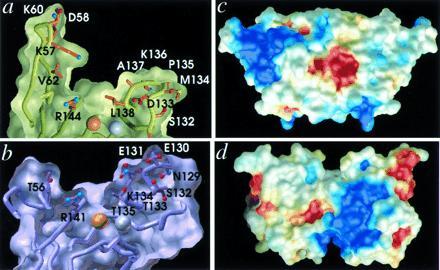Figure 4.

Conservation and variation of the active channel shape and electrostatic potential between P- and E-class CuZnSODs. (a) Active-site channel cross-section for P-class PhCuZnSOD and (b) E-class BSOD. Whereas the shape and dimensions are conserved between the two classes (at left, PhCuZnSOD Val-62 coincides with BSOD Thr-56 in the SS loop, and at right, PhCuZnSOD Leu-138 coincides with BSOD Thr-135 in loop 7,8), the structural location, conformation, and identity of the residues producing the long-range electrostatic attraction of the substrate anion are dramatically different, suggesting separate divergent evolution followed by convergence. Electrostatic potential mapped onto the molecular surface of the PhCuZnSOD dimer (c) (oriented to match Fig. 1a) and the BSOD dimer (d) (oriented to match Fig. 1b) and colored as blue positive potential (>3kT/q) and red negative potential (<−3kT/q). The network of charged residues Lys-57, Asp-58, and Lys-60, in the extended PhCuZnSOD SS loop (upper left) forms the positive potential for substrate attraction, whereas Glu-131, Glu-132, and Lys-134 in the extended loop 7,8 (lower right) provide the equivalent function in BSOD.
